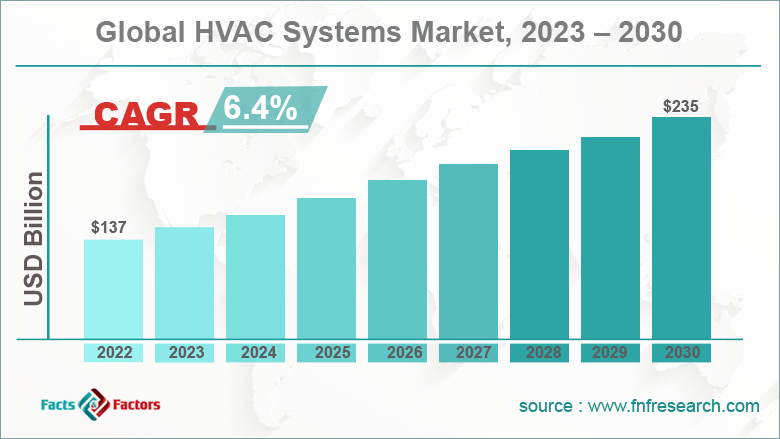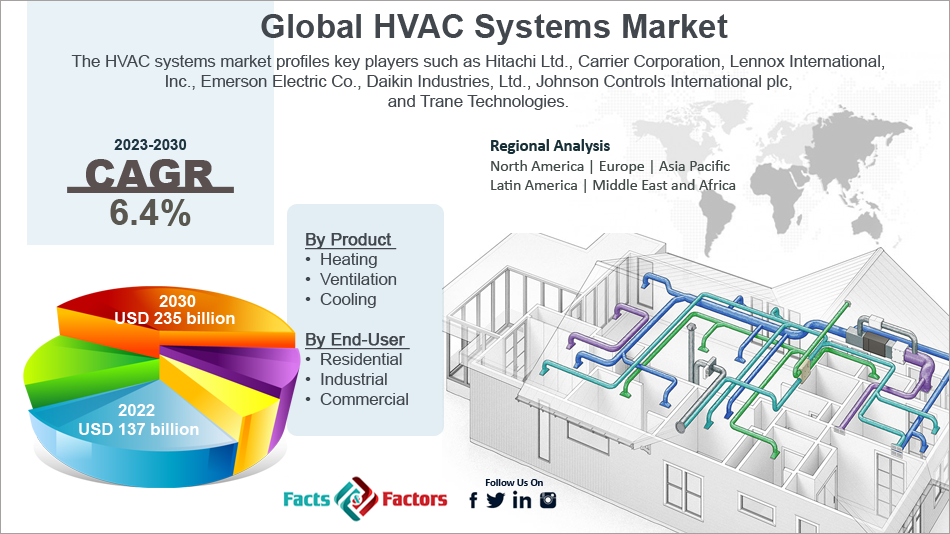Search Market Research Report
HVAC Systems Market Size, Share Global Analysis Report, 2023 – 2030

HVAC Systems Market Size, Share, Growth Analysis Report By Product (Heating, Ventilation, and Cooling), By End-Use (Residential, Industrial, and Commercial), and By Region - Global and Regional Industry Insights, Overview, Comprehensive Analysis, Trends, Statistical Research, Market Intelligence, Historical Data and Forecast 2023 – 2030
Industry Insights
[227+ Page Report] According to the report published by Facts & Factors, the global HVAC systems market size was evaluated at $137 billion in 2022 and is slated to hit $235 billion by the end of 2030 with a CAGR of nearly 6.4% between 2023 and 2030. The market report is an indispensable guide on growth factors, challenges, restraints, and opportunities in the global marketspace. The HVAC systems industry report covers the geographical market along with a comprehensive competitive landscape analysis. It also includes cash flow analysis, profit ratio analysis, market basket analysis, market attractiveness analysis, PESTEL analysis, SWOT analysis, Porter’s five force analysis, and value chain analysis. Additionally, the HVAC systems market report explores the investor and stakeholder space to help companies make data-driven decisions.

 Market Overview
Market Overview
HVAC systems are referred to as heating, ventilation, and air conditioning tools that make use of a slew of technologies for regulating humidity, temperature, and purity of air in a closed space. These systems are the pivotal components of residential structures including hotels, single family households, apartments, and senior living units. Furthermore, the design of the HVAC system is based on thermodynamics principles, heat transfer principles, and principles of fluid mechanics.
 Key Insights
Key Insights
- As per the analysis shared by our research analyst, the global HVAC systems market is projected to expand annually at the annual growth rate of around 6.4% over the forecast timespan (2023-2030)
- In terms of revenue, the global HVAC systems market was evaluated at nearly $137 billion in 2022 and is expected to reach $235 billion by 2030.
- The global HVAC systems market is anticipated to record massive growth over the forecast period owing to changing climatic conditions and the necessity of maintaining ambient environments in various buildings.
- Based on the product, the cooling segment is predicted to contribute majorly towards the global market share over the forecast timeline.
- In terms of end-use, the residential segment is projected to account for a major share of the global market in 2023-2030.
- Region-wise, the North American HVAC Systems market is projected to register the highest CAGR during the assessment period.

 Industry Growth Factors
Industry Growth Factors
- Massive demand for energy conservation to boost the global market trends
Changing climatic conditions and the necessity of maintaining ambient environments in various buildings will steer the global HVAC systems market demand. Furthermore, the growing demand for power conservation will boost global market trends. In addition to this, escalating demand for sustainable constructions will impel the expansion of the market across the globe. Large-scale preference for smart households and the popularity of eco-friendly HVAC systems for reducing GHG emissions will proliferate the growth of the global market. Furthermore, the massive penetration of smart HVAC systems in building automation will embellish the scope of growth for the global market.
In addition to this, a surge in the construction activities in the industrial as well as residential sectors will protrude the growth of the global HVAC systems market in the upcoming years. Swift urbanization and industrialization will contribute majorly towards the market proceeds in the years ahead. Surge in demand for ventilation, hybrid heating, and cooling systems will spur the growth of the market across the globe.
 Restraints
Restraints
- Huge maintenance charges can decimate the global industry trends over 2023-2030
Huge maintenance and deployment costs as well as a rise in the repairing charges can put brakes on the expansion of the global HVAC systems industry. Less availability of skilled personnel can further impede global industry growth.
 Opportunities
Opportunities
- Surging inclination towards use of software-based HVAC systems to generate new horizons of growth for the global market
Growing preference for software-driven HVAC systems will open new opportunities for growth for the global HVAC systems market. Massive demand for commercial HVAC will generate new facades of growth for the global market.
 Challenges
Challenges
- Less know-how about advantages derived through use of HVAC systems can be a challenge to the industry growth globally
Low awareness about benefits accrued due to HVAC system installation in emerging economies can be a big challenge for the global HVAC systems industry expansion. Less allocation of funds to HVAC infrastructure & training programs can be a challenging task for the global industry.
 Segmentation Analysis
Segmentation Analysis
The global HVAC systems market is sectored into product, end-use, and region.
In terms of product, the global HVAC systems market is sectored into heating, ventilation, and cooling segments. Furthermore, the cooling segment, which accounted for more than 55% of the global market share in 2022, is set to retain its segmental domination in the anticipated timeline. The segmental surge in the coming eight years can be a result of a rise in population & disposable income leading to the purchase of air-conditioners. As per IEA, cooling contributes to nearly 11% of the global power consumption leading to huge demand for HVAC systems in the cooling segment.
Based on the end-use, the HVAC systems industry across the globe is divided into residential, industrial, and commercial segments. Moreover, the residential segment, which accumulated nearly 40% of the global industry share in 2022, is slated to dominate the global industry surge even in the forecasting years. The growth of the segment in the coming years can be due to the humungous demand for HVAC systems in the residential segment. Surging population in developing countries will further accentuate the demand for HVAC systems in the residential segment.
 Recent Breakthroughs:
Recent Breakthroughs:
- In the first half of 2023, Daikin Europe N.V., a division of Daikin Industries Ltd., signed a partnership agreement with Greater Manchester Combined Authority. The move is aimed at increasing the use of heat pumps and providing training on operating HVAC systems to technicians.
- In the first quarter of 2023, Johnson Controls International, a U.S.-based firm manufacturing HVAC & security equipment for buildings, acquired Hybrid Energy AS, a major provider of high-temperature energy management solutions including heat pumps for industrial processes & district heating. The strategic initiative is aimed at providing cost-efficient solutions to end-users along with addressing environmental concerns such as decarbonization in Europe.
- In the first half of 2023, Ahlstrom-Munksjö Oyj, a key player in the fiber-based products sector, introduced an HVAC filter media product portfolio from its unit in Italy. The move is likely to help in offering high-quality filters to the end-users that will deliver outstanding performance & reduce environmental impact. The product launch will contribute majorly towards the product line and add to the size of the global HVAC market across Europe.
 Report Scope
Report Scope
Report Attribute |
Details |
Market Size in 2022 |
USD 137 Billion |
Projected Market Size in 2030 |
USD 235 Billion |
CAGR Growth Rate |
6.4% CAGR |
Base Year |
2022 |
Forecast Years |
2023-2030 |
Key Market Players |
Hitachi Ltd., Carrier Corporation, Lennox International Inc., Emerson Electric Co., Daikin Industries Ltd., Johnson Controls International plc, Trane Technologies, and others. |
Key Segment |
By Product, End-User, and Region |
Major Regions Covered |
North America, Europe, Asia Pacific, Latin America, and the Middle East &, Africa |
Purchase Options |
Request customized purchase options to meet your research needs. Explore purchase options |
 Regional Insights
Regional Insights
- Asia-Pacific to contribute majorly towards the global HVAC systems market share over the forecast timeline
Asia-Pacific, which accounted for more than 42% of the global HVAC systems market revenue in 2022, is anticipated to dominate the global market proceeds even during the assessment timeline. The regional market expansion over 2023-2030 can be due to surging population, rise in per capita spending capacity of consumers, and urbanization. Apart from this, the rise in the use of HVAC systems in the commercial sector of the region will steer the regional market trends.
Furthermore, the North American HVAC systems industry is set to record the fastest CAGR in the forecasting timeframe. The factors that are likely to determine the growth of the regional market include new revenue streams created by OEMs in the region and the presence of giant players in the countries such as the U.S. Apart from this, renovation of old infrastructure in countries such as Canada and the U.S. will contribute notably towards the regional industry revenue share in the coming years.
 Competitive Space
Competitive Space
- Hitachi Ltd.
- Carrier Corporation
- Lennox International Inc.
- Emerson Electric Co.
- Daikin Industries Ltd.
- Johnson Controls International plc
- Trane Technologies
The global HVAC Systems market is segmented as follows:
 By Product
By Product
- Heating
- Ventilation
- Cooling
 By End-User
By End-User
- Residential
- Industrial
- Commercial
 By Regional Segment Analysis
By Regional Segment Analysis
- North America
- The U.S.
- Canada
- Mexico
- Europe
- France
- The UK
- Spain
- Germany
- Italy
- Nordic Countries
- Denmark
- Sweden
- Norway
- Benelux Union
- Belgium
- The Netherlands
- Luxembourg
- Rest of Europe
- Asia Pacific
- China
- Japan
- India
- Australia
- South Korea
- Southeast Asia
- Indonesia
- Thailand
- Malaysia
- Singapore
- Rest of Southeast Asia
- Rest of Asia Pacific
- The Middle East & Africa
- Saudi Arabia
- UAE
- Egypt
- South Africa
- Rest of the Middle East & Africa
- Latin America
- Brazil
- Argentina
- Rest of Latin America
Industry Major Market Players
- Hitachi Ltd.
- Carrier Corporation
- Lennox International Inc.
- Emerson Electric Co.
- Daikin Industries Ltd.
- Johnson Controls International plc
- Trane Technologies
Frequently Asked Questions

Copyright © 2024 - 2025, All Rights Reserved, Facts and Factors


